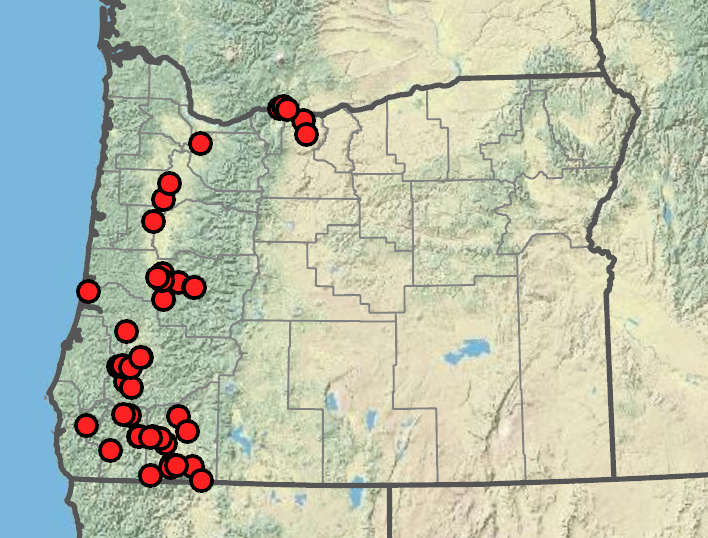Trifolium ciliolatum
Trifolium dubium
foothill clover
little hop clover, suckling clover
palmate;
leaflets 3, elliptic to oblong or obovate, 8–35 × 5–15 mm, bases cuneate;
margins serrate proximally, obscurely denticulate distally;
veins thickened;
tips usually rounded or retuse, rarely acute;
surfaces glabrous;
petioles 10–130 mm;
petiolules ~0.5 mm;
stipules ovate-lanceolate, 10–15 mm;
margins entire, sometimes ciliate;
tips acuminate.
pinnate;
leaflets 3, obovate to elliptic-lanceolate, 10–20 × 5–15 mm, bases cuneate;
margins dentate distally;
lateral veins prominent; ± parallel, ascending;
tips rounded or retuse;
surfaces glabrous or with scattered hairs;
petioles ? 15 mm;
petiolules? 0.5 mm in lateral leaflets, 1–1.5 mm in terminal leaflets;
stipules ovate, 3–5 mm;
margins entire;
tips acute.
axillary or terminal, 10–30-flowered; ovoid becoming subglobose, 7–22 × 5–20 mm;
involucres a narrow, membranous, dentate rim; ~0.5 mm;
bracteoles linear or cup-shaped; ? 1 mm.
axillary or terminal, 5–20-flowered; ovoid or globose, 5–9 × ~6 mm;
involucres absent;
bracteoles reduced to fringe of red setae.
25–120 mm.
10–15 mm.
erect but becoming reflexed, 0.5–6 mm.
reflexed, 0.2–0.5 mm.
6–13 mm;
calyces broadly campanulate, 5–11 mm, glabrous;
veins 10;
tubes 1–5 mm;
lobes elliptic to linear, unequal;
margins hyaline, markedly ciliate, dentate or pectinate; sinuses narrow;
orifices open;
corollas 5–13 mm, white, pink, or purple;
banners broadly ovate, 6–13 × 4–7 mm;
tips rounded, apiculate.
2.8–3.5 mm;
calyces campanulate, 1.5–2 mm, glabrous;
veins 5;
tubes 0.8–1 mm;
lobes unequal; > tube; adaxial 2 shorter;
orifices open;
corollas 2.6–3.2 mm, pale yellow becoming brown, not or slightly ribbed;
banners persistent, spatulate, 2.6–3.2 × 2 mm;
tips rounded to broadly acute.
longitudinally dehiscent; ovoid, 5–10 mm; < 2 × as long as calyces; short-stipitate.
ellipsoidal, 1.5–2 mm; ? calyces; short-beaked, stipitate.
1–2; ovoid, 2.5–3 mm, brown, mottled; smooth.
1, ellipsoid, 0.9–1 mm, yellow or pale brown;
surfaces smooth; glossy.
=16.
=16, 28, 32.
Trifolium ciliolatum
Trifolium dubium
Oak-pine chaparral, meadows, roadsides. Flowering May–Jun. 50–800 m. Col, ECas, Sisk, WV. CA, WA; south to Mexico. Native.
Disturbed ground, fields. Flowering Apr–Jul. 0–1700 m. BW, Casc, CR, Est, Lava, Sisk, WV. CA, ID, NV, WA; throughout North America but absent from central Canada; worldwide. Exotic.
Trifolium dubium is native to Eurasia and is widely introduced as a weed worldwide. It may be confused with Medicago lupulina, but the latter can be distinguished by its obviously toothed stipules, deciduous corollas, and shiny, black fruits. Little hop clover may be the “shamrock” of Irish folklore (Nelson 1991), though other candidates include other species of Trifolium or species of Medicago or Oxalis.
Michael Vincent
Michael Vincent
- Local floras:
BC,
CA,
OR,
WA
- Local Web sites:
CalFlora,
CalPhotos,
Flora NW,
PNW Herbaria,
Turner Photog.
WildflowerSearch
iNaturalist (observations)
USDA Plants Database
- LBJ Wildflower Center
- SEINet
- Plants of the World Online
- Encyclopedia of Life
- Wikipedia
- Google Image Search





